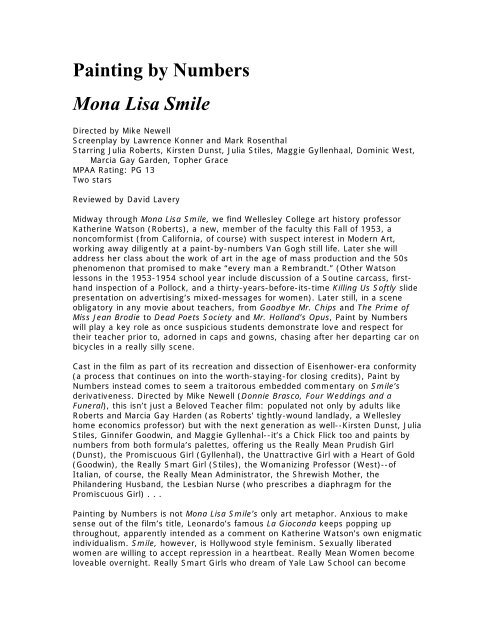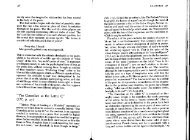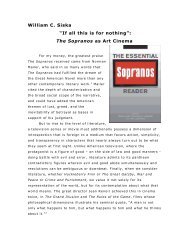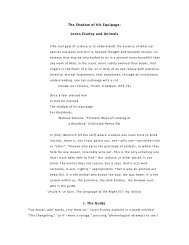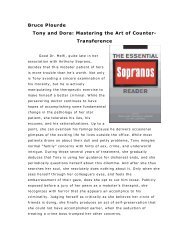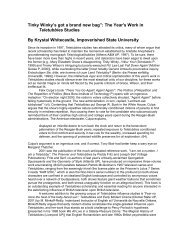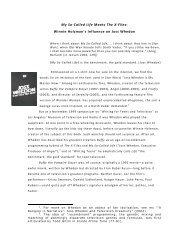Painting by Numbers Mona Lisa Smile - David Lavery
Painting by Numbers Mona Lisa Smile - David Lavery
Painting by Numbers Mona Lisa Smile - David Lavery
You also want an ePaper? Increase the reach of your titles
YUMPU automatically turns print PDFs into web optimized ePapers that Google loves.
<strong>Painting</strong> <strong>by</strong> <strong>Numbers</strong><br />
<strong>Mona</strong> <strong>Lisa</strong> <strong>Smile</strong><br />
Directed <strong>by</strong> Mike Newell<br />
Screenplay <strong>by</strong> Lawrence Konner and Mark Rosenthal<br />
Starring Julia Roberts, Kirsten Dunst, Julia Stiles, Maggie Gyllenhaal, Dominic West,<br />
Marcia Gay Garden, Topher Grace<br />
MPAA Rating: PG 13<br />
Two stars<br />
Reviewed <strong>by</strong> <strong>David</strong> <strong>Lavery</strong><br />
Midway through <strong>Mona</strong> <strong>Lisa</strong> <strong>Smile</strong>, we find Wellesley College art history professor<br />
Katherine Watson (Roberts), a new, member of the faculty this Fall of 1953, a<br />
noncomformist (from California, of course) with suspect interest in Modern Art,<br />
working away diligently at a paint-<strong>by</strong>-numbers Van Gogh still life. Later she will<br />
address her class about the work of art in the age of mass production and the 50s<br />
phenomenon that promised to make “every man a Rembrandt.” (Other Watson<br />
lessons in the 1953-1954 school year include discussion of a Soutine carcass, firsthand<br />
inspection of a Pollock, and a thirty-years-before-its-time Killing Us Softly slide<br />
presentation on advertising’s mixed-messages for women). Later still, in a scene<br />
obligatory in any movie about teachers, from Good<strong>by</strong>e Mr. Chips and The Prime of<br />
Miss Jean Brodie to Dead Poets Society and Mr. Holland’s Opus, Paint <strong>by</strong> <strong>Numbers</strong><br />
will play a key role as once suspicious students demonstrate love and respect for<br />
their teacher prior to, adorned in caps and gowns, chasing after her departing car on<br />
bicycles in a really silly scene.<br />
Cast in the film as part of its recreation and dissection of Eisenhower-era conformity<br />
(a process that continues on into the worth-staying-for closing credits), Paint <strong>by</strong><br />
<strong>Numbers</strong> instead comes to seem a traitorous embedded commentary on <strong>Smile</strong>’s<br />
derivativeness. Directed <strong>by</strong> Mike Newell (Donnie Brasco, Four Weddings and a<br />
Funeral), this isn’t just a Beloved Teacher film: populated not only <strong>by</strong> adults like<br />
Roberts and Marcia Gay Harden (as Roberts’ tightly-wound landlady, a Wellesley<br />
home economics professor) but with the next generation as well--Kirsten Dunst, Julia<br />
Stiles, Ginnifer Goodwin, and Maggie Gyllenhal--it’s a Chick Flick too and paints <strong>by</strong><br />
numbers from both formula’s palettes, offering us the Really Mean Prudish Girl<br />
(Dunst), the Promiscuous Girl (Gyllenhal), the Unattractive Girl with a Heart of Gold<br />
(Goodwin), the Really Smart Girl (Stiles), the Womanizing Professor (West)--of<br />
Italian, of course, the Really Mean Administrator, the Shrewish Mother, the<br />
Philandering Husband, the Lesbian Nurse (who prescribes a diaphragm for the<br />
Promiscuous Girl) . . .<br />
<strong>Painting</strong> <strong>by</strong> <strong>Numbers</strong> is not <strong>Mona</strong> <strong>Lisa</strong> <strong>Smile</strong>’s only art metaphor. Anxious to make<br />
sense out of the film’s title, Leonardo’s famous La Gioconda keeps popping up<br />
throughout, apparently intended as a comment on Katherine Watson’s own enigmatic<br />
individualism. <strong>Smile</strong>, however, is Hollywood style feminism. Sexually liberated<br />
women are willing to accept repression in a heartbeat. Really Mean Women become<br />
loveable overnight. Really Smart Girls who dream of Yale Law School can become
subservient housewives at the drop of a mortar board. Again and again cake is eaten<br />
and had too.<br />
Still, the acting in <strong>Smile</strong> is uniformly good and the film (shot <strong>by</strong> Anastas N. Michos)<br />
looks splendid (though hardly the equal of its far superior fellow 50s flick Far from<br />
Heaven). For a paint <strong>by</strong> numbers exercise, it’s well done, but it’s hardly an original.<br />
It will never be hung in an art museum.


